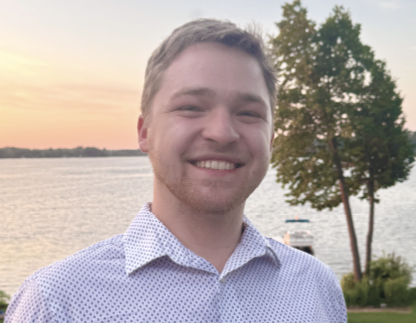Growing up, chemistry was the science of wizardry.”
Peter Carlson
PhD Student in the Department of Chemistry

Peter Carlson is a PhD student in the Department of Chemistry in the Weinberg College of Arts and Sciences. He investigates how a molecule’s electrons interact with its atomic structure during a chemical reaction using ultrafast laser spectroscopy, with the goal of improving reaction control and sustainability. He is a recipient of the IIN Ryan Fellowship.
How would you describe your research and/or work to a non-academic audience?
In the Gaynor Group, we use a series of intense laser pulses to generate maps that describe how a molecule's electrons interact with its atomic structure during a chemical reaction. This information allows us to better control chemical reactions and improve their sustainability. Right now, I'm helping build a new laser beamline to characterize and optimize important reactions that occur at an interface.
Tell us what inspired your research and/or work.
During my junior year of undergrad at the University of Minnesota, I took a graduate quantum mechanics course with Dr. Renee Frontiera. In class, she led several interesting discussions on modern physical chemistry research and invited me to her group meetings for a better technical perspective. It was there I found a strong appreciation for ultrafast spectroscopy and made the decision to pursue a PhD.
What do you find both rewarding and challenging about your research and/or work?
Growing up, chemistry was the science of wizardry. I've found it really rewarding to see that chemistry can be described by a language: applied quantum mechanics. Chemistry demands a lot of different skills from a researcher, but a strong foundation in physics and mathematics leads to powerful insights about the most basic chemistry fundamentals. These tools are foundational in spectroscopy, where we use the quantum nature of light to elucidate information about a molecule or reaction of interest.
Why Northwestern?
Northwestern has an abundance of resources to make good science happen. I feel really privileged to be able to make use of the many scientific resources and to be able to collaborate with leading researchers in my field. From a physical chemistry perspective, we are well situated to help characterize the optoelectronic properties of many of the interesting nanomaterials developed here. Additionally, the graduate student union and the chemistry program administration here is excellent, responsive and supportive.
What books are on your bedside table?
I just started When Christ and His Saints Slept by Sharon Kay Penman. I'm a big fan of historical fiction and political intrigue, especially in a medieval England setting. I'm also reading Sword at Sunset by Rosemary Sutcliff, a powerful and gritty retelling of the Arthurian legend.
What advice would you give your younger self or someone considering a similar path?
Growing up, I was set on becoming a marine biologist specializing in the behavior of giant squid. I eventually got into contact with giant squid expert Dr. Steve O'Shea, who gave me some important advice I would have liked to have known earlier: life throws curveballs and forces us to reinvent ourselves. If it wasn't for his suggestion, I probably wouldn't have been open-minded enough to pivot to chemistry during undergrad and be doing what I'm most passionate about.
Publish Date: October 21, 2025